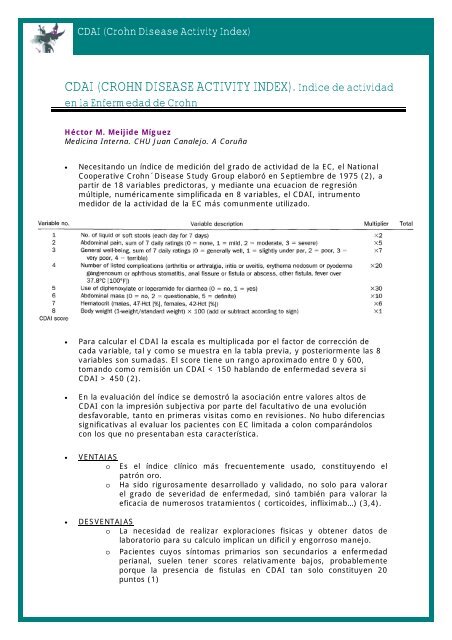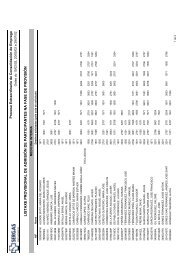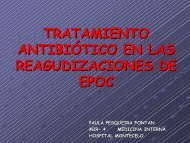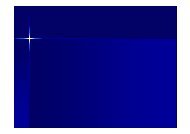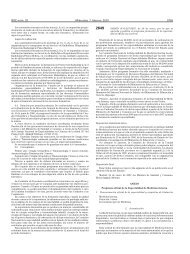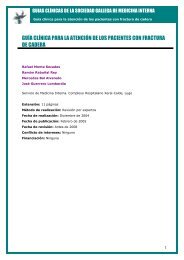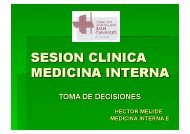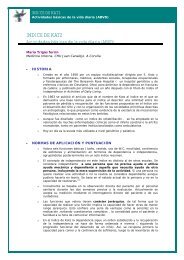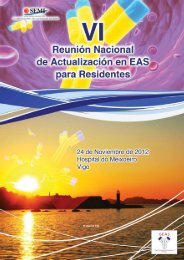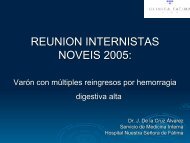CDAI (CROHN DISEASE ACTIVITY INDEX). Indice de actividad
CDAI (CROHN DISEASE ACTIVITY INDEX). Indice de actividad
CDAI (CROHN DISEASE ACTIVITY INDEX). Indice de actividad
Create successful ePaper yourself
Turn your PDF publications into a flip-book with our unique Google optimized e-Paper software.
<strong>CDAI</strong> (Crohn Disease Activity In<strong>de</strong>x)<br />
<strong>CDAI</strong> (<strong>CROHN</strong> <strong>DISEASE</strong> <strong>ACTIVITY</strong> <strong>INDEX</strong>). <strong>Indice</strong> <strong>de</strong> <strong>actividad</strong><br />
en la Enfermedad <strong>de</strong> Crohn<br />
Héctor M. Meiji<strong>de</strong> Míguez<br />
Medicina Interna. CHU Juan Canalejo. A Coruña<br />
• Necesitando un índice <strong>de</strong> medición <strong>de</strong>l grado <strong>de</strong> <strong>actividad</strong> <strong>de</strong> la EC, el National<br />
Cooperative Crohn´Disease Study Group elaboró en Septiembre <strong>de</strong> 1975 (2), a<br />
partir <strong>de</strong> 18 variables predictoras, y mediante una ecuacion <strong>de</strong> regresión<br />
múltiple, numéricamente simplificada en 8 variables, el <strong>CDAI</strong>, intrumento<br />
medidor <strong>de</strong> la <strong>actividad</strong> <strong>de</strong> la EC más comunmente utilizado.<br />
• Para calcular el <strong>CDAI</strong> la escala es multiplicada por el factor <strong>de</strong> corrección <strong>de</strong><br />
cada variable, tal y como se muestra en la tabla previa, y posteriormente las 8<br />
variables son sumadas. El score tiene un rango aproximado entre 0 y 600,<br />
tomando como remisión un <strong>CDAI</strong> < 150 hablando <strong>de</strong> enfermedad severa si<br />
<strong>CDAI</strong> > 450 (2).<br />
• En la evaluación <strong>de</strong>l índice se <strong>de</strong>mostró la asociación entre valores altos <strong>de</strong><br />
<strong>CDAI</strong> con la impresión subjectiva por parte <strong>de</strong>l facultativo <strong>de</strong> una evolución<br />
<strong>de</strong>sfavorable, tanto en primeras visitas como en revisiones. No hubo diferencias<br />
significativas al evaluar los pacientes con EC limitada a colon comparándolos<br />
con los que no presentaban esta característica.<br />
• VENTAJAS<br />
o Es el índice clínico más frecuentemente usado, constituyendo el<br />
patrón oro.<br />
o Ha sido rigurosamente <strong>de</strong>sarrollado y validado, no solo para valorar<br />
el grado <strong>de</strong> severidad <strong>de</strong> enfermedad, sinó también para valorar la<br />
eficacia <strong>de</strong> numerosos tratamientos ( corticoi<strong>de</strong>s, infliximab…) (3,4).<br />
• DESVENTAJAS<br />
o La necesidad <strong>de</strong> realizar exploraciones fisicas y obtener datos <strong>de</strong><br />
laboratorio para su calculo implican un dificil y engorroso manejo.<br />
o Pacientes cuyos síntomas primarios son secundarios a enfermedad<br />
perianal, suelen tener scores relativamente bajos, probablemente<br />
porque la presencia <strong>de</strong> fistulas en <strong>CDAI</strong> tan solo constituyen 20<br />
puntos (1)
<strong>CDAI</strong> (Crohn Disease Activity In<strong>de</strong>x)<br />
Otros índices <strong>de</strong> <strong>actividad</strong> en la Enfermedad <strong>de</strong> Crohn<br />
• Existen otros scores que se han utilizado como predictores en la EC, como son<br />
el Simple In<strong>de</strong>x, Cape Town o el índice OMGE, que también han sido<br />
correctamente validados y correlacionados con el <strong>CDAI</strong>, aunque mucho menos<br />
utilizados (1). También ha sido bien validado el <strong>Indice</strong> Van Hees, pero su<br />
correlación con el <strong>CDAI</strong> y restantes es débil, probablemente por la mayor<br />
inclusión <strong>de</strong> items <strong>de</strong> laboratorio (5).<br />
• Por último, con respecto a la EC, cabe mencionar dos índices más, el I.<br />
Endoscópico y el I. Histológico. Si bien es verdad que solo el primero está<br />
perfectamente validado (1), consi<strong>de</strong>ramos que ninguno <strong>de</strong> los dos tienen cabida<br />
en este capítulo que es eminemente clínico.<br />
BIBLIOGRAFIA<br />
1. William J. Sandborn et al, A Review of Activity <strong>Indice</strong>s and Efficacy Endpoints<br />
for Clinical Trials of Medical Therapy in Adults With Crohn´s Disease.<br />
Gastroenterology 2002; 122:512-530.<br />
2. William R. Best et al, Development of a Crohn´s Disease Activity In<strong>de</strong>x.<br />
Gastroenterology 1976; 70:439-444.<br />
3. Summers RW et al, National Cooperative Crohn´s Disease Study: results of<br />
drug treatment. Gastroenterology 1979;77:847-869.<br />
4. Targan SR et al. A short-term study of chimeric monoclonal antibody cA2 to<br />
tumor necrosis factor alpha for Crohn´s Disease. N Eng J Med<br />
1997;337:1029-1035.<br />
5. Van Hees PA et al. An in<strong>de</strong>x of inflammatory activity in patients with<br />
Crohn´s Disease.Gut 1980;21:279-286.


